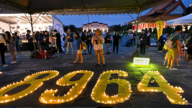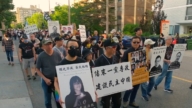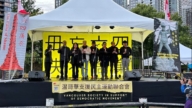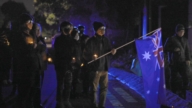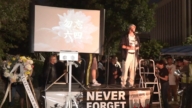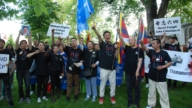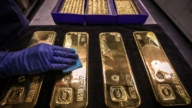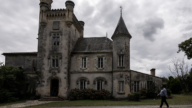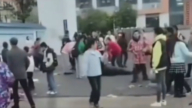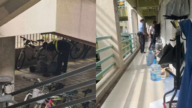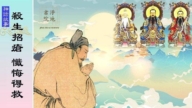【新唐人2014年04月28日訊】經過多年計劃和籌款之後,由「香港市民支持民主愛國運動聯合會」主持的《永久六四紀念館》,26號在九龍尖沙咀正式開幕。香港「支聯會」表示,設立目前全球唯一的「六四紀念館」,是希望能保存歷史,傳承真相,呼喚良知,推動「平反六四」以及中國的民主發展。而評論認為,香港逐漸淪喪為中共的殖民地,香港成立「六四紀念館」,標誌著港人正式對中共政權說「不」。
支聯會主席李卓人、副主席麥海華以及多位曾見證「八九民運」的香港嘉賓,在開幕儀式上,一起撕碎《人民日報》將學運定性為動亂的「四二六」社論影印本,作為開館儀式。
1989年4月26號,中共喉舌《人民日報》發表社論,將在天安門廣場悼念前改革派領導人胡耀邦逝世而引發的學生運動,定性為反革命動亂,從而激化了政府和人民的矛盾,並導致了「八九民主運動」,也後來演變成了「六四」慘案。
香港「六四紀念館」特地選在25年後的這一天,正式對民眾開放參觀。
旅美中國社會問題研究人士張健表示,建立「六四紀念館」,標誌著香港人民對中國民主的擔憂,對中國未來走向的關注,也標誌著香港人民對自己的未來會被中共逐漸蠶食的擔憂。
旅美中國社會問題研究人士張健:「香港由過去一個自由港,一直到回歸到中共體制內之後,香港逐漸的淪喪為中共的殖民地。香港現在已經完全喪失了它的法制和民主這樣一種精神,它再也不是亞洲的一個旗幟。」
張健認為,「六四紀念館」開館的這一天,就是標誌著在這一個時間點上,對中共政權說「不」。
有50家世界各地的媒體、近百記者採訪了「六四紀念館」,包括《路透社》、《半島電視臺》等。
紀念館下午開放三小時,眾多參觀者排起了長隊等待入館參觀,不僅有香港人也有從中國大陸來的90後大學生。
不過,有10多名親北京政府的團體人士在附近抗議,他們指責「永久六四博物館」的籌建者是「叛徒」,並擺設街板展覽,還一度對參觀紀念館的市民指罵。
過去幾個星期以來,也有「六四紀念館」同一幢建築的其他業主,由於安全的擔憂,要求紀念館關閉。
多年來,中共從未提供「動用坦克和軍隊清場」而死亡的學生和市民數字,官媒也一直迴避「六四」問題。但不可否認的是,「六四」事件是對中國近來發展方向影響最大的事件。
中共前領導人趙紫陽秘書鮑彤指出,氾濫全國的腐敗、墮落和違法現象,是1989年後開始的。
原中共中央農村政策研究室研究員姚監復對「六四」的評價是:當權者用「六四」的鮮血保證了政權的「穩定」。
姚監復還指出,「六四」的槍聲,毀滅了中國人對民主、自由的期望和追求理想、關心政治的熱情,同時還封死了人們的嘴巴和良心:「惹不起,還躲不起!?」、「好死不如賴活著」成了人們的生活信條。中國人的道德感、責任感、使命感消失了,淡化了。
香港《新世紀》出版社負責人鮑樸也曾親歷「六四」,他感受到:「六四事件槍響之後,人人都知道這個政府,只要你上街他就會抓你甚至會開槍,政府從此以後也立下了規矩,只要公民去抗議,哪怕是和平的、是合法的,他們也要去鎮壓。」
不過,張健表示,「六四」後,對中共最堅定和最勇敢的反抗團體,就是信仰「真善忍」的「法輪功」團體。
張健:「他們弘揚真善忍,用這種理性和平非暴力的方式,來去和中共常年來做鬥爭,這是非常不容易的事情。所以我今天才說,真正中國人的脊樑、民族的驕傲,就是應該是這些大法的弟子們。」
4月25號,是法輪功和平上訪「反迫害」的第一個日子。張健指出,把「六四紀念館」開幕日定在法輪功「4.25」15週年紀念日後的這一天,也許是天意,是上天從另一方面對大法的支持。
採訪/朱智善 編輯/宋風 後製/蕭宇
The First June 4 Museum Opens In Hong Kong:
A Denial of The Chinese Communist Party.
After years of planning and fundraising, a permanent
museum to remember the Tiananmen Square Crackdown
on June 4 of 1989 has officially opened on April 26 in Hong
Kong’s Tsim Sha Tsui tourist district.
The Hong Kong Alliance in Support of Patriotic Democratic
Movements of China (the Alliance), said they built the
museum, currently the only one that commemorates the
June 4 Incident globally, to preserve and spread the truth.
In addition, the museum can serve as a call of conscience
and a promotion to China’s democratization.
Commentators said as Hong Kong was made its colony by
the Chinese Communist Party (CCP) opening of the June 4
Museum marked Hong Kong people saying “No” to the CCP.
Lee Cheuk-yan, chairman of the Alliance and Mak Hoi-wah,
vice chairman of the Alliance, attended the museum opening
ceremony along with many witnesses of China’s 1989 protests.
In the ceremony, they destroyed photocopies of the April 26
Editorial published by the People’s Daily, which called the
student movement a revolt.
On April 26, 1989, the party mouthpiece People’s Daily
published an article on the student movement motivated
by the death of former reformist party leader Hu Yaobang.
The article defined the students’ mourning activities
at the Tiananmen Square as an anti-CCP revolt.
This greatly intensified the conflicts between the Chinese
people and the CCP, which led to a massive democratic
movement followed by the massacre on June 4, 1989.
The opening date of June 4 museum was selected on the 25th
Anniversary of the April 26 Editorial.
The museum was officially opened to the public on that day.
Zhang Jian, a US-based China social issue researcher, said the
opening of June 4 museum marks how Hong Kong people are
worrying about China’s democratization and the state’s future.
Meanwhile, they also worry that the CCP is gradually
taking control of Hong Kong’s future.
Zhang Jian: ”Since the Handover, Hong Kong has been
gradually turned into the party’s colony from a free port.
Now Hong Kong has almost lost its principles in the ruling of
law and democracy, and so no longer serves as a banner in Asia.
Zhang Jian commented that, the opening of the June 4
museum marked Hong Kong’s people saying “No” to the
CCP at such as critical moment.
Along with Reuters and Al Jazeera, about fifty media from
all over the world and a hundred journalists reported on
the opening ceremony.
The museum was open for three hours in the afternoon.
Visitors that queued to enter the museum included not just
Hong Kong residents but also post-90’s undergraduates
from mainland China.
On the other hand, a dozen pro-CCP activists protested
near the museum.
They claimed organizers of the museum are “betrayers”.
They set up a street booth for propaganda and even
shouted swear words at museum visitors.
In the past few weeks, some business owners sharing the
same building with the museum also requested the museum
close due to safety concerns.
Over the years, the CCP has never mentioned a death toll in
its crackdown of students and civilians with tanks and troops.
All CCP official media never touch the topic of June 4 Incident.
It is still an undeniable fact that the incident is most
influential to China’s development direction since 1989.
Bao Tong, former secretary of CCP leader Zhao Ziyang, said
corruption, moral degeneration and all kinds of illegal acts
started to spread over the whole state after 1989.
Yao Jianfu, former State Council research fellow on rural
polices, said party leaders had chosen to maintain “stability”
of the CCP with blood in the June 4 Incident.
Yao Jianfu further commented that the 1989 crackdown
completely destroyed Chinese peoples’ expectations of
democracy and freedom, and passion for political awareness.
It shut down peoples’ mouths and killed their consciences.
“I cannot touch the problems but I can escape from them”
or “A living dog is better than a dead lion” became new
principles of Chinese people.
The consciousness of morality, responsibility and
vocation gradually disappeared in China.
Bao Pu, director of Hong Kong’s New Century Press,
experienced the June 4 Incident himself.
Bao said: ”After the crackdown on June 4, it became
clear to everyone that the CCP will arrest you or even
shoot you if you do any street protests.
The CCP also set the example that they will suppress any
protests even if they are peaceful and legal.”
Zhang Jian said, since the June 4 Incident, the group that
protests against the CCP most persistently and with the most
courage, are Falun Gong practitioners who believe in
“Truthfulness, Compassion and Tolerance”.
Zhang Jian: “They stick with the principle of ‘Truthfulness,
Compassion and Tolerance’, and have protested against
the CCP year on year in a rational and peaceful manner.
That is really something very difficult to do.
Therefore I can conclude now that China’s real strength
and pride are inside those Falun Gong practitioners.”
April 25 is also the first important date when Falun Gong
practitioners began their peaceful protests against the CCP
persecution in 1999.
Zhang Jian believes that, the June 4 museum opened right
after Falun Gong’s 15 anniversary of “April 25 Petition”.
This coincidence could be divine will that shows its
support of Falun Gong.
Interview/Zhu Zhishan Edit/SongFeng Post-Production/XiaoYu



